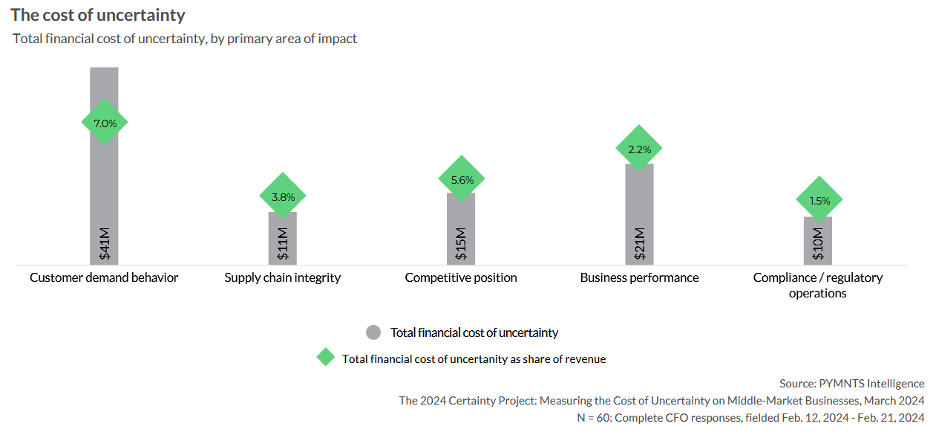
According to PYMNTS Intelligence’s inaugural edition of “The 2024 Certainty Project Report,” uncertainty costs middle-market companies more than $20 million on average, per these firms’ CFOs.
The 2024 Certainty Project is a first-of-its kind study examining the economic impact that uncertainty has on firms operating on the smaller end of the middle-market spectrum, earning revenues between $100 million and $250 million.
The study found that larger firms tended to have a greater sense of certainty. CFOs at larger firms said they have the resources needed to meet organizational growth and innovation goals. This helps explain why 57% say they operate at high levels of certainty.
Meanwhile, PYMNTS Intelligence data shows that mid-market companies operate against a much starker backdrop: 47% of CFOs from smaller firms face considerable uncertainty. That share is more than double the 21% faced by CFOs operating in the largest income bracket of $750 million to $1 billion. As a result of this uncertainty, middle-market firms lose approximately 4.4% of their annual revenues due to uncertainty.

It takes a massive financial toll. Over a 12-month period, smaller companies felt the financial strain of economic uncertainty to the tune of $21 million, on average, according to the CFOs surveyed in the report.
However, these CFOs say different factors shape the uncertainty.
Chief among them: changing customer demand, which costs smaller firms that identified this issue as uncertainty’s primary impact $41 million on average, or 7% of their revenue. Those firms that said their biggest source of uncertainty are supply-chain challenges lost an average of $11 million, or 3.8% of revenue. Compliance and regulatory uncertainty, for comparison, came with a $10 million price tag — or 1.5% of annual revenue.
PYMNTS Intelligence also tracked the fallout of uncertainty — and its residual costs. Middle-market firms that cited unpredictability’s most significant impact as experiencing missed opportunities saw losses of $17 million. Those citing reduced profit margins as the end result reported losses of $33 million, on average. And those struggling mainly with excess inventory costs reported a 4.8% loss of annual revenue, a $17 million hit.